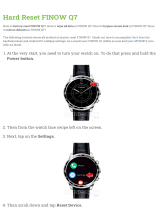
Rotate On most screens, you can automatically change the screen orientation
from portrait to landscape by turning your phone sideways. When
entering text, you can turn your phone sideways to bring up a bigger
onscreen keyboard.
Pinch In some apps, like Pictures or the web browser, you can “pinch” the
screen using two fingers (for example, thumb and index finger) to zoom
in or zoom out when viewing a picture or web page.
Setting up your phone for the first time
When you switch on your phone for the first time, you’ll be asked to set it up. Just
follow the onscreen instructions and you’ll be up and running in no time.
Be sure to sign in with your Windows Live
®
ID so you can use services such as
Hotmail
®
, Marketplace, Xbox LIVE
®
, and more.
Start screen
Up front on the Start screen, you'll see live tiles that continuously update and show
what’s most personal to you. You’ll see things like your photo album, how many new
messages and email you have, and more.
§ Simply swipe your finger up or down to scroll through the tiles.
§ On the Start screen, tap to access apps and settings.
§ To return to the Start screen from any app or setting's screen, press .
Rearranging tiles
1. Press and hold the tile you want to move until it floats.
2. Drag the tile where you want it to go.
3. Keep rearranging until all tiles are where you want them.
4. When you're done moving tiles, tap anywhere onscreen or press .
Pinning items to the Start screen
You can pin just about anything you want to the Start screen: apps, pictures, songs,
favorite websites, documents, and even contacts.
For example, when you pin a contact to the Start screen, you’ll get all of that person’s
updates — feeds, email, text messages, and call notifications — right from that tile.
1. To pin something, press and hold it until a menu appears.
2. Tap pin to start.
14 Getting started





















